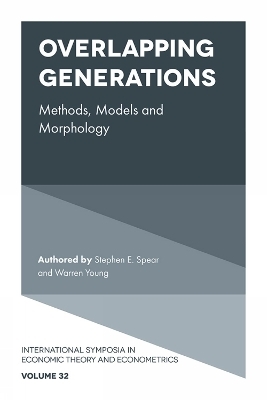
Overlapping Generations
Emerald Publishing Limited (Verlag)
978-1-83753-053-3 (ISBN)
The 800 pound gorilla in the room of macroeconomics is the question of why the overlapping generations model didn’t become the central workhorse model for macroeconomics. Introduced in 1958 by Paul Samuelson, the model postulates an infinite number of finite-lived families. This is in stark contrast to the more dominant neoclassical growth model, which is based on the assumption that real economies are populated by a finite number of dynastic families. Despite the greater realism of the former model and the inherent implausibility of the assumptions underlying the growth model, the growth model has become dominant. The authors here explore the co-evolution of the two models to shed light on why this happened, spanning the entire post-WWII era.
Stephen E. Spear is Professor of Economics at Tepper School of Business, Carnegie Mellon University, Pittsburgh, USA. Warren Young is Professor Emiratus at the Department of Economics, Bar Ilan University, Ramat Gan, Israel.
Introduction. Introduction
Chapter 1. Origins of the Workhorse Models
Chapter 2. OLG – The Next Generations, 1960-1970
Chapter 3. Expectations and the Neutrality of Money c. 1972: From OLG to SOLG
Chapter 4. Infinite Lived Agents: Dynasty, 1970-1980
Chapter 5. OLG and Money, 1970-1980
Chapter 6. OLG and Theory, 1970-1980
Chapter 7. Boomers
Chapter 8. Gen X and Beyond: 1995-2015
Chapter 9. The Ascendance of ILA and the Future of Macro
Chapter 10. Morphology of OLG Models and Methods in Comparative Perspective
Chapter 11. Summary and Conclusion
| Erscheinungsdatum | 26.08.2023 |
|---|---|
| Reihe/Serie | International Symposia in Economic Theory and Econometrics |
| Verlagsort | Bingley |
| Sprache | englisch |
| Maße | 152 x 229 mm |
| Gewicht | 508 g |
| Themenwelt | Wirtschaft ► Betriebswirtschaft / Management ► Finanzierung |
| Betriebswirtschaft / Management ► Spezielle Betriebswirtschaftslehre ► Bankbetriebslehre | |
| Wirtschaft ► Betriebswirtschaft / Management ► Wirtschaftsinformatik | |
| ISBN-10 | 1-83753-053-X / 183753053X |
| ISBN-13 | 978-1-83753-053-3 / 9781837530533 |
| Zustand | Neuware |
| Informationen gemäß Produktsicherheitsverordnung (GPSR) | |
| Haben Sie eine Frage zum Produkt? |
aus dem Bereich


